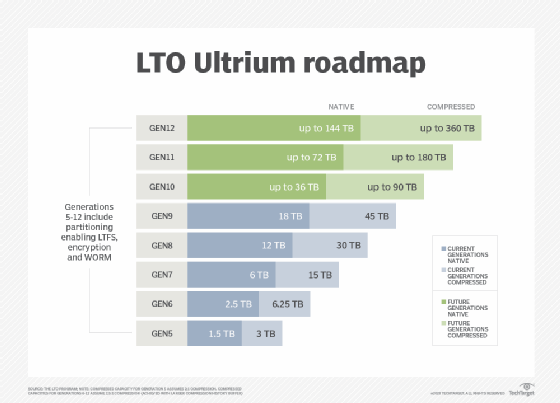What's driving the resurgence in tape storage use? (original) (raw)
For well over a decade, IT vendors and experts alike have proclaimed tape to be dead. However, the rumors of tape's demise have been greatly exaggerated.
Tape storage technology is in the middle of a resurgence. This renaissance is the result of a number of factors, including improvements in the technology and its ability to protect against cyber attacks.
New technologies in tape storage include higher capacities
Even though tapes have stored data for almost as long as computers have existed, tape storage technology continues to improve.
For example, the LTO Program first released its standard in 2000. LTO-1 tape had a capacity of only 100 GB native, or 200 GB compressed.
In 2021, the LTO Program released the ninth generation of the LTO specification. LTO-9 tapes have a native capacity of 18 TB and can store up to 45 TB of compressed data. Additionally, a compressed tape features read speeds of up to 1000 MBps. Even an uncompressed tape has read speeds up to 400 MBps. This rate is far faster than the first-generation LTO tapes, which had a maximum speed of 20 MBps for an uncompressed tape or 40 MBps for a compressed tape. However, it's still much slower than the access times of disk and flash.

Data growth and deletion concerns
According to some estimates, the volume of data that most organizations have will double every few years. Conventional wisdom has long held that it is nearly impossible to keep pace with such rampant data growth. As such, many organizations have adopted strict data lifecycle management policies that will automatically delete aging data and drive down storage costs.
However, purging old data might mean that an organization can't capitalize on a long-term trend that it might have been able to spot had enough historical data existed. Organizations have found that they can use machine learning to unlock hidden business value in existing data.
Tape storage technology use may be an answer. Just as cloud providers use tape storage for archives, organizations can use the massive storage capacity offered by newer standards and migrate their infrequently accessed data to cheaper tapes.
Even though tapes have stored data for almost as long as computers have existed, tape storage technology continues to improve.
Protection against cyber attacks
The constant threat of ransomware is a major reason for the recent popularity of tape storage use.
Early on, ransomware was simply designed to encrypt its victims' data. The easiest way to recover from a ransomware attack was to restore a backup. However, ransomware authors eventually figured out that backups were the one thing standing between them and the ransom. As such, cybercriminals began developing ransomware that could actively attack an organization's backups.
Tape storage technology is largely immune to these types of attacks. Tape can serve as an air-gapped data copy. In other words, an administrator can write data to a tape, eject the cartridge and store it in a safe place. Ransomware cannot attack data on a tape that is not mounted in a drive.
In addition, newer LTO standards feature write-once, read-many technology. It's possible to write to a tape so other users can't alter that data. In the context of ransomware, an attacker can't encrypt a tape's contents.
Cloud providers' tape storage use
Some experts thought the public cloud would render tape obsolete and would ultimately be responsible for its death. Ironically, however, hyperscale cloud providers are among the biggest consumers of tape storage. In fact, many businesses that use cloud storage don't realize that the providers write some data to tape.
Cloud providers such as Microsoft and AWS offer various tiers of storage. The cheapest storage tier is usually an archive tier, which organizations use to store data that they rarely access but need to retain. These cloud providers can offer archive storage at such a low cost because they store the data on tape rather than on online spinning disks.
Issues with tape and workarounds
In spite of the resurgence in tape use, there are some shortcomings. First, tape is a linear media, which means that it isn't the best choice for workloads that perform random I/O. Tape tends to be fast when performing sequential reads and writes but can be slow when it needs to locate specific data.
Tape media can survive for decades, but in order to achieve this longevity, users need to store it in an area with the proper temperature and humidity levels. In addition, tape is removable, so administrators must ensure that security controls will prevent the theft of sensitive data.